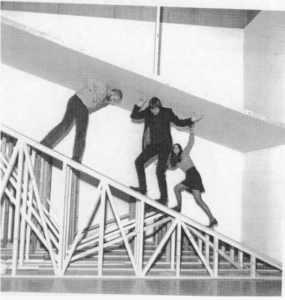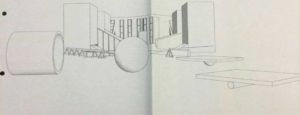

https://www.tate.org.uk/research/publications/performance-at-tate/perspectives/robert-morris
Bodyspacemotionthings, 2009, is a re-staging of a Robert Morris exhibition in 1971. this consisted of ‘interactive sculptures that would experiment with conceptions about sculptural space and human physicality by having museum-goers put their own bodies to the test’. industrial materials in the forms of ramps, cylinders and climbing walls took up the Turbine Hall for four days which was originally intended to be five weeks. ‘Before the show’s opening, Tate staff had posed for photographs depicting the intended method of meeting each challenge; these images were affixed to the appropriate pieces’, these constraints placed onto the exhibition were not entirely followed by participants, who exceeded these limitations to a point of damaging the structures. it can be viewed as contradictory to allow participation as ‘an opportunity for people to involve themselves with the work, to become aware of their own bodies, gravity, effort, fatigue, their bodies under different conditions’ (Morris) but to also situate instructions with each object. to ‘become aware’ of your own body, using these structures to do so, requires freedom and an allowance for flexibility in individuals deciding how something may be interacted with. this could also be a way of enabling play through constraint; accommodating to adult participants who may need more stimuli to engage with each form. the Bodyspacemotionthings version of this was modified to prepare for a similarly enthusiastic range of participants of the 1971 original, by using more durable materials and having more staff present.
all quotations: https://www.tate.org.uk/research/publications/performance-at-tate/perspectives/robert-morris
this reminds me of an undergrad crit where a fellow student created a free-standing sculpture made of found materials that was intended to be interactive. they were disappointed at how ‘much’ the piece had been engaged with and did not concur with their own perceptions of what would happen. we summarised that constraining methods could ‘help’ the work reach a goal that was closer to what the artist intends, but by giving the work an interactive label is essentially ‘giving it over’ to others versions of engagement and what interactive means. as this happened at a university private view, the variable of who the participant is becomes crucial as art students seeing the opportunity for interaction may take this further as there are less inhibitions and more knowledge around what being a participant means.
(https://www.tate.org.uk/research/publications/performance-at-tate/perspectives/robert-morris)

Leave a Reply